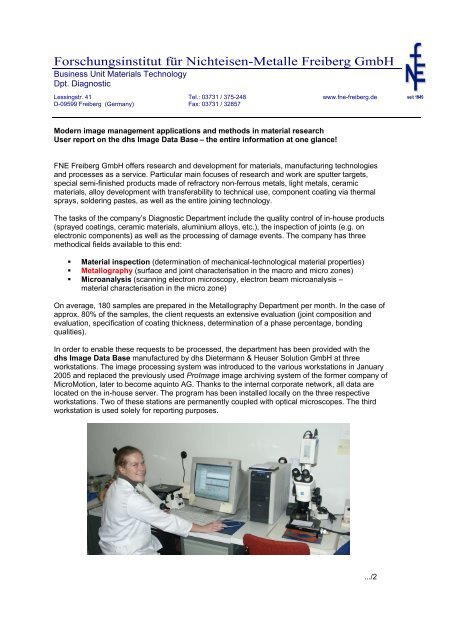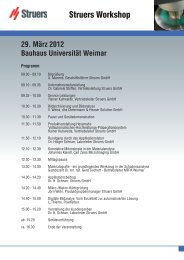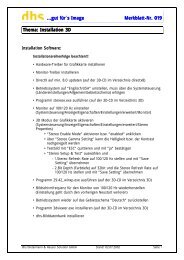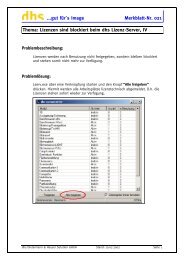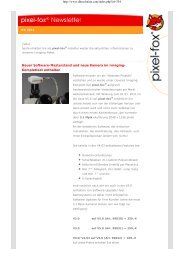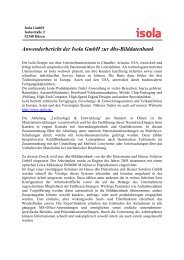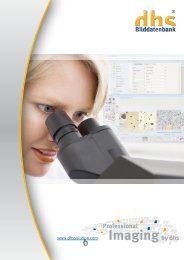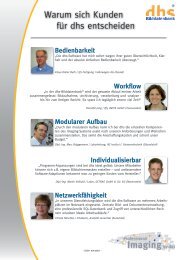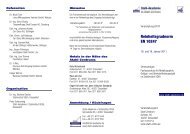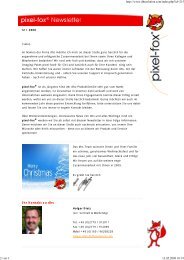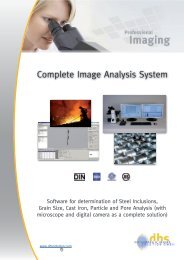User Testimonial - dhs
User Testimonial - dhs
User Testimonial - dhs
You also want an ePaper? Increase the reach of your titles
YUMPU automatically turns print PDFs into web optimized ePapers that Google loves.
Forschungsinstitut für Nichteisen-Metalle Freiberg GmbH<br />
Business Unit Materials Technology<br />
Dpt. Diagnostic<br />
Lessingstr. 41 Tel.: 03731 / 375-248 www.fne-freiberg.de<br />
D-09599 Freiberg (Germany) Fax: 03731 / 32857<br />
Modern image management applications and methods in material research<br />
<strong>User</strong> report on the <strong>dhs</strong> Image Data Base – the entire information at one glance!<br />
FNE Freiberg GmbH offers research and development for materials, manufacturing technologies<br />
and processes as a service. Particular main focuses of research and work are sputter targets,<br />
special semi-finished products made of refractory non-ferrous metals, light metals, ceramic<br />
materials, alloy development with transferability to technical use, component coating via thermal<br />
sprays, soldering pastes, as well as the entire joining technology.<br />
The tasks of the company’s Diagnostic Department include the quality control of in-house products<br />
(sprayed coatings, ceramic materials, aluminium alloys, etc.), the inspection of joints (e.g. on<br />
electronic components) as well as the processing of damage events. The company has three<br />
methodical fields available to this end:<br />
� Material inspection (determination of mechanical-technological material properties)<br />
� Metallography (surface and joint characterisation in the macro and micro zones)<br />
� Microanalysis (scanning electron microscopy, electron beam microanalysis –<br />
material characterisation in the micro zone)<br />
On average, 180 samples are prepared in the Metallography Department per month. In the case of<br />
approx. 80% of the samples, the client requests an extensive evaluation (joint composition and<br />
evaluation, specification of coating thickness, determination of a phase percentage, bonding<br />
qualities).<br />
In order to enable these requests to be processed, the department has been provided with the<br />
<strong>dhs</strong> Image Data Base manufactured by <strong>dhs</strong> Dietermann & Heuser Solution GmbH at three<br />
workstations. The image processing system was introduced to the various workstations in January<br />
2005 and replaced the previously used ProImage image archiving system of the former company of<br />
MicroMotion, later to become aquinto AG. Thanks to the internal corporate network, all data are<br />
located on the in-house server. The program has been installed locally on the three respective<br />
workstations. Two of these stations are permanently coupled with optical microscopes. The third<br />
workstation is used solely for reporting purposes.<br />
.../2
<strong>User</strong> report <strong>dhs</strong> Image Data Base<br />
___________________________________________________________________________<br />
-2-<br />
Initially, the data specific to orders, materials and customers are captured and archived in the <strong>dhs</strong><br />
system, thus guaranteeing the possibility of long-term access. The relevant data to every image is<br />
recorded during image acquisition. In addition, the use of video converters (frame grabbers) allows<br />
the analogous cameras of the stereomicroscope as well as the macro-stand to be integrated in the<br />
system and photos to be archived.<br />
The rapid software-driven switchover between the camera systems results in a considerable time<br />
saving. In addition, the automatic number assignment during acquisition also ensures a simple and<br />
rapid search in the case of queries.<br />
Efficient methods of image processing and image analysis with a high level of utilisation<br />
1. Use of the “Panoramic Image“ module for displaying overview photographs:<br />
Two individual images were<br />
combined to achieve this resulting<br />
image. It is still possible to change<br />
the brightness and contrast of each<br />
individual image when joining the<br />
two together. In addition, the<br />
images can be rotated either<br />
individually or together at a defined<br />
variable angle.<br />
.../3
<strong>User</strong> report <strong>dhs</strong> Image Data Base<br />
___________________________________________________________________________<br />
2. Determination of the phase percentage in an alloy (Area Detection):<br />
3. Evaluating “Coating Thicknesses”:<br />
-3-<br />
Original Image Result<br />
Any objects which cuts<br />
the edges were ignored<br />
in the result image. The<br />
interesting greyscale<br />
value is detected with the<br />
aid of a variable<br />
threshold value.<br />
The applied coating thicknesses<br />
were specified in the<br />
acquired image. In order to<br />
determine a statistically<br />
guaranteed average value,<br />
the measurement can be<br />
achieved by applying a grid<br />
at a defined interval. All<br />
measurement values can be<br />
either directly processed<br />
(addition, creation of an<br />
average value, etc.) or can<br />
be transferred into an Excel<br />
table for more extensive<br />
calculations by means of a<br />
fully automatic process.<br />
Conclusion:<br />
Using the <strong>dhs</strong> Image Data Base guarantees simple and convenient data archiving and reporting.<br />
Due to the clear and simple handling, the use of the various software modules (Panoramic Image,<br />
Sharpness Reconstruction, Area Detection, inter alia.) proves very helpful when evaluating the<br />
joints. As one can imagine, very little training is required for the software. When creating quality<br />
reports including a large number of images, various page designs can be created in the desired<br />
layout and in an appealingly clear format as MS Word- document templates (forms). The image<br />
databank workflow was designed in such a way by the software manufacturer <strong>dhs</strong> Dietermann &<br />
Heuser Solution GmbH, that it can be adapted to meet the requirements of one’s own company<br />
with little effort.<br />
The complex archiving of all the images and documents associated with a project guarantees that<br />
individual processes can be quickly retraced at any time. In conclusion, one can summarise that<br />
the easy handling, the broad functionality spectrum, as well as the option of individually adjusting<br />
the database allows the user an optimal mode of operation.


